“ANYTHING FER THANKSGIVING?”
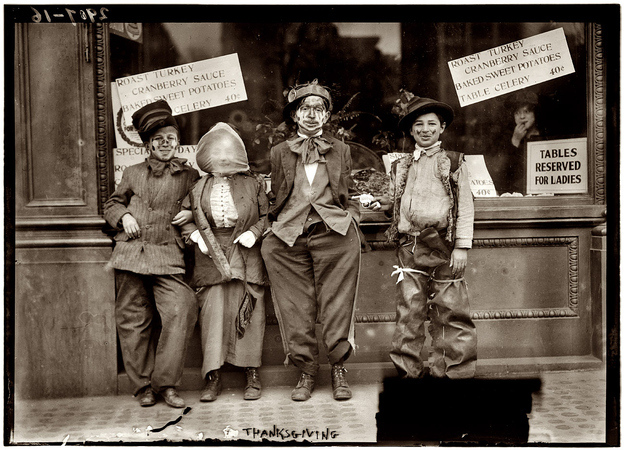
******************************************************************************************************************************** Brownstone Detectives investigates the history of our clients’ homes. The story you are about to read was composed from research conducted in the course of one of those investigations. Do you know the history of YOUR house? ******************************************************************************************************************************** Before there was Halloween “trick-or-treating” – there was another tradition in Brooklyn: Thanksgiving “begging.” A STORY ABOUT CHILDREN PANHANDLING IN BROOKLYN Most people have never heard of this custom, but that is because it ended sometime in the 1940s or 1950s here in the northeastern part of the U.S. But in the process of doing research on a brownstone for a Brownstone Detectives House History Book, we tracked down a former resident who, during her interview, and to our great surprise, began telling us about this defunct holiday. “In the morning we were dressed up as hobos, in whatever old clothes our parents gave us,” said Patricia O’Neill who used to live at 738 Macon Street in the eastern section of Bedford-Stuyvesant, “and we went from door to door saying, ‘Anything for Thanksgiving?’ “They used to give us a dime or an apple.” O’Neill (Loftus at the time) remembers the custom well. Where she grew up in Bedford-Stuyvesant, all of the kids dressed as hobos and they spent the morning of Thanksgiving Day carousing the neighborhood “begging” for food and money from their neighbors. THE HISTORY The custom which started around 1870 may have a connection to Martinmas, the feast day of St. Martin of Tours, patron saint of beggars and […]
HALLOWEEN ON THE SUBWAY (1922)
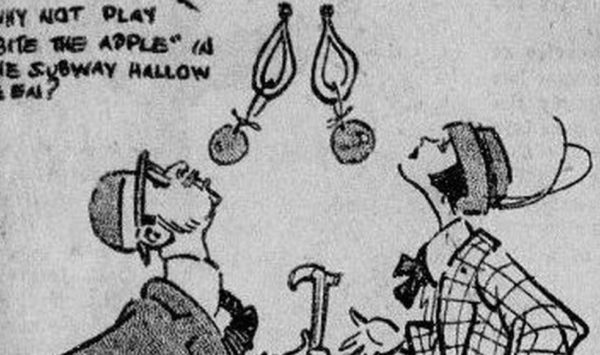
******************************************************************************************************************************** Brownstone Detectives investigates the history of our clients’ homes. The story you are about to read was composed from research conducted in the course of one of those investigations. Do you know the history of YOUR house? ******************************************************************************************************************************** Those of you who live in New York might have seen costumers on the subway during your commute today. It is less likely, though, that you saw straphangers bobbing for apples. At the time of this cartoon’s publication in the October 29th, 1922 edition of the New York Tribune, the subway was a mere 18-year-old. And the term “straphanger” was not much older – it derived from the (at first leather, and later metal) straps which hung from the ceiling of a street or subway car. “Why not play ‘bite the apple’ in the subway Halloween?”, shows two New Yorkers, a “dudish” man and an “artsy” woman (two typical subway riders of the day?) “bobbing” for apples from those straps. When was the last time you played this game??? Follow @BrownstoneDetec Share ———————————————————————————————————————– The Brownstone Detectives Brownstone Detectives is an historic property research agency. Our mission is to document and save the histories of our clients’ homes. From our research, we produce our celebrated House History Books and House History Reports. Contact us today to begin discovering the history of your home.
THE GHOST OF 281 STUYVESANT AVENUE (1901)
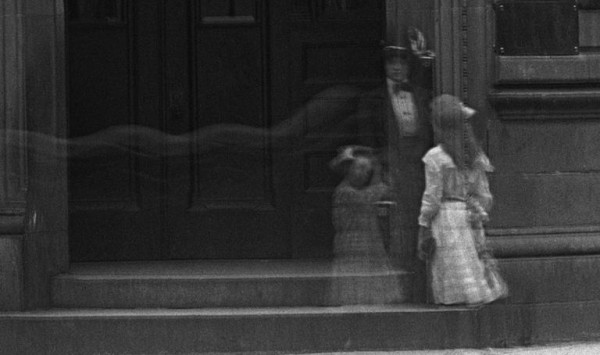
******************************************************************************************************************************** Brownstone Detectives investigates the history of our clients’ homes. The story you are about to read was composed from research conducted in the course of one of those investigations. Do you know the history of YOUR house? ******************************************************************************************************************************** “At last Stuyvesant Heights revels in the proud possession of a genuine haunted house.” This was back in 1901, when Stuy Heights was relatively young, the houses newish, and the ghosts scarce. But Stuyvesant Heights had everything back then – “a Republican Club, an amateur dramatic society,” and even “several asphalt streets where bashful maidens learn to wheel at night.” So why not a ghost? THE HAUNTING AT NO. 281 STUYVESANT AVENUE The Griffins, who had lived in the apartment house at the ground floor were terrorized by their electric bell ringing at 2 o’clock every afternoon. But they also heard “hollow groans,” “creepy sidesteps on the staircase,” and “unexpected trips from room to room of pieces of furniture.” It all got to be too much for the Griffins to handle, and so they fled. The Griffins moved to Williamsburgh. PERFECTLY GOOD EXPLANATIONS Some of the other tenants blamed the wind. A young woman who lived in the second floor apartment told an Eagle reporter that everything was perfectly explainable. “This house, you know, stands alone and the wind, when it sweeps into the vestibule, often comes hard enough to blow the whistle in the kitchen tube,” she explained. “Then it’s a fact that the pictures do move, but that’s caused […]
BROWNSTONE DETECTIVES IN THE NY POST!
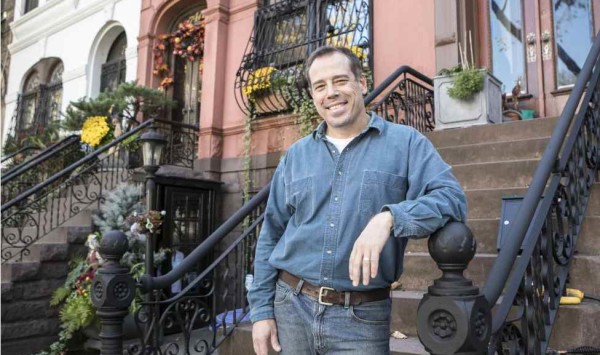
“Because Brooklynite Brian Hartig delves into the history of old New York homes every day, he comes across a few ghost stories,” wrote New York Post writer, Emily Nonko. Hartig, who creates House History Books containing the full histories of his clients’ Brooklyn houses, was told recently that his house was haunted by a benign spirit. (Read the rest of the story at the New York Post website.)
“SWEATING” HALLOWEEN TOYS IN 1921 BROOKYLN
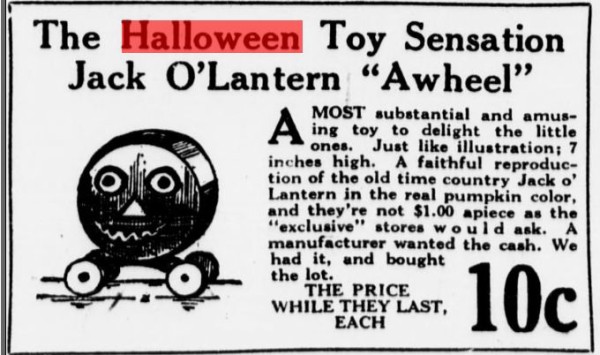
How this toy worked is quite simple, but apparently, at least according to this ad in the October 31st, 1921 edition of the New York World, it was a “most substantial and amusing toy to delight the little ones.” The ad further noted that the Halloween Toy Sensation, the Jack O’Lantern “Awheel,” was “7 inches high,” and was a “faithful reproduction of the old time country Jack o’Lantern in the real pumpkin color.” In reality it was simply a locally mass-produced means of making money off of an annual holiday. The toy was probably made of wood which was placed on a base with wheels and hand-colored by some young ladies in a sort of “sweat shop” somewhere in Brooklyn. As a seasonal item they were probably produced quickly in a carpentry shop and assembled at a rapid pace – then the girls likely learned how to hand color the “faces” as they went along. “Awheel” was an old word which meant to travel by auto or bicycle and was used in a similar fashion to “afoot.” This Jack O’Lantern, obviously, was traveling by wheel – “to the delight the little ones.” And at 10 cents a piece, it sounded like a deal. Follow @BrownstoneDetec ———————————————————————————————————————– The Brownstone Detectives This story was composed from research performed by The Brownstone Detectives. Allow us do an in-depth investigation of your house and its former owners and produce your very own House History Book. Your hardbound coffee table book will include an illustrated […]